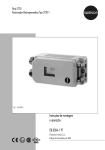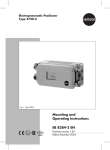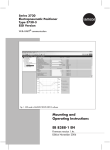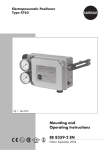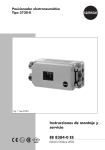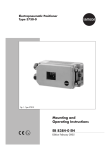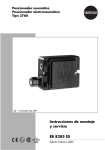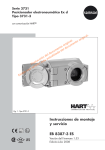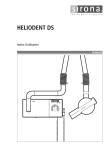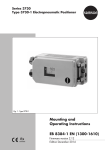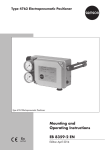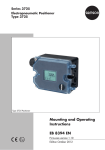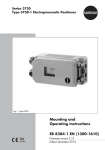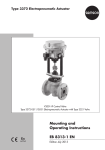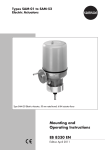Download Mounting and Operating Instructions EB 8384-1 EN
Transcript
Electropneumatic Positioner Type 3730-1 Fig. 1 · Type 3730-1 Mounting and Operating Instructions EB 8384-1 EN Firmware version 2.0x Edition February 2005 Contents Contents Page 1 Design and principle of operation . . . . . . . . . . . . . . . . . . . 6 2 2.1 2.1.1 2.1.2 2.2 2.3 2.4 2.5 Attachment to the control valve – mounting parts and accessories . . . . 9 Direct attachment . . . . . . . . . . . . . . . . . . . . . . . . . . . 12 Type 3277-5 Actuator. . . . . . . . . . . . . . . . . . . . . . . . . 12 Type 3277 Actuator . . . . . . . . . . . . . . . . . . . . . . . . . . 14 Attachment according to IEC 60534-6 . . . . . . . . . . . . . . . . . 16 Attachment to Type 3510 Micro-flow Valve. . . . . . . . . . . . . . . 18 Attachment to rotary actuators . . . . . . . . . . . . . . . . . . . . . 20 Reversing amplifier for double-acting actuators . . . . . . . . . . . . . 22 3 3.1 3.1.1 3.1.2 3.2 Connections . . . . . Pneumatic connections Signal pressure gauges Supply pressure . . . . Electrical connections . 4 4.1 Operation . . . . . . . . . . . . . . . . . . . . . . . . . . . . . . 28 Operator controls . . . . . . . . . . . . . . . . . . . . . . . . . . . 28 5 5.1 5.2 5.3 5.4 5.5 5.6 5.7 Start-up . . . . . . . . . . . . Setting the volume restriction Q . . Adapting the display . . . . . . Determining the fail-safe position Setting other parameters . . . . Initialization . . . . . . . . . . Faults . . . . . . . . . . . . . . Zero calibration . . . . . . . . . 6 Code list . . . . . . . . . . . . . . . . . . . . . . . . . . . . . . . 34 7 Maintenance . . . . . . . . . . . . . . . . . . . . . . . . . . . . . 38 8 Servicing explosion-protected devices . . . . . . . . . . . . . . . . . 38 9 Dimensions in mm . . . . . . . . . . . . . . . . . . . . . . . . . . 39 . . . . . . . . . . . . . . . . . . . . . . . . . . . . . . . . . . . . . . . . . . . . . . . . . . . . . . . . . . . . . . . . . . . . . . . . . . . . . . . . . . . . . . . . . . . . . . . . . . . . . . . . . . . . . . . . . . . . . . . . . . . . . . . . . . . . . . . . . . . . . . . . . . . . . . . . . . . . . . . . . . . . . . . . . . . . . . . . . . . . . . . . . . . . . . . . . . . . . . . . . . . . . . . . . . . . . . . . . . . . . . . . . . . . . . . . . . . . . . . . . . . . . . . . . . . . . . . . . . . . . . . . . . . . . . . . 24 24 24 24 26 29 29 30 30 30 31 32 33 Certificates . . . . . . . . . . . . . . . . . . . . . . . . . . . . . . 40 2 EB 8384-1 EN Safety instructions General safety instructions 4 The positioner may only be assembled, started up or operated by trained 4 4 4 4 and experienced personnel familiar with the product. According to these mounting and operating instructions, trained personnel is referred to as individuals who are able to judge the work they are assigned to and recognize possible dangers due to their specialized training, their knowledge and experience as well as their knowledge of the relevant standards. Explosion-protected versions of this positioner may only be operated by personnel who have undergone special training or instructions or who are authorized to work on explosion-protected devices in hazardous areas. Refer to section 8 on Servicing explosion-protected versions. Any hazards that could be caused by the process medium, the operating pressure, the signal pressure or by moving parts of the control valve are to be prevented by means of the appropriate measures. If inadmissible motions or forces are produced in the actuator as a result of the supply pressure level, it must be restricted by means of a suitable supply pressure reducing station. Proper shipping and appropriate storage are assumed. 4 Note! The device with a CE marking fulfils the requirements of the Directives 94/9/EC (ATEX) and 89/336/EEC (EMC). The declaration of conformity can be viewed and downloaded on the Internet at http://www.samson.de. EB 8384-1 EN 3 Technical data Positioner Nominal travel Direct attachment to Type 3277: 3.75 to 30 mm Attachment acc. to IEC 60534-6: 5 to 200 mm Nominal angle Attachment acc. to VDI/VDE 3845 Travel range Adjustable within the rated travel/nominal angle Reference variable w Signal range 4 to 20 mA, split-range 4 to 11.9 mA and 12.1 to 20 mA, Static destruction limit 100 mA. Minimum current 3.7 mA Load impedance ≤ 6 V (corresponding to 300 Ω at 20 mA) Supply air Supply pressure from 1.4 to 6 bar (20 to 90 psi), Air quality acc. to ISO 8573-1: Max. particle size and density: Class 4 Oil content: Class 3, pressure dew point: Class 3 or at least 10 K beneath the lowest ambient temperature to be expected Signal pressure (output) 0 bar up to supply pressure, limitable to approx. 2.4 bar via software Characteristic Selection: 1 characteristic for globe valves, 8 characteristics for opening angle Hysteresis ≤1% 24° to 100° Sensitivity ≤ 0.1 % Transit time < 0.5 s for initialization not permissible, adaptation over volume restriction Q Direction of action w/x reversible Air consumption, st. state Independent from supply pressure approx. 110 ln/h Air delivery Actuator pressurized Actuator vented At ∆p =6 bar: ≥ 8.5 mn3/h, at ∆p = 1.4 bar: 3.0 mn3/h at ∆p =6 bar: ≤ 14.0 mn3/h, at ∆p = 1.4 bar: 4.5 mn3/h KVmax(20 °C) = 0.09 KVmax(20 °C) = 0.15 Permissible ambient temperature –20 to +80 °C, with metal cable gland –40 to +80 °C The limits specified in the EC Type Examination Certificate additionally apply for explosion-protected devices. Influences Temperature: ≤ 0.15 %/10 K Supply air: None Vibration: ≤ 0.25 % up to 2000 Hz and 4 g acc. to IEC 770 Electromagnetic compatibility Complying with requirements specified in EN 61000-6-2, EN 61000-6-3 and NAMUR Recommendation NE 21 Explosion protection II 2 G EEx ia IIC T6 / II 2 D IP 65 T 80 °C or II 3 G EEx nA/nL IIC T6 / II 3 D IP 65 T 80 °C Degree of protection IP 65 Materials Die-cast aluminum GD AlSi12 acc. to DIN 1725 ( 3.2582), chromated and plastic coated; External parts: Stainless steel 1.4571 and 1.4301 Weight Approx. 1 kg 4 EB 8384-1 EN Technical data 2 software limit switches with configurable limit values (0.5 % steps), with reverse polarity protection Binary contacts Signal status No response: Response: Operating voltage Without explosion protection Conductive (R = 348 Ω) Non-conducting Explosion-protected version ≥ 2.1 mA ≤ 1.2 mA For connection to binary input of the PLC acc. to EN 61131, Pmax = 400 mW Only for connection to NAMUR signal converter acc. to EN 60 957-5-6 EB 8384-1 EN 5 Design and principle of operation 1 Design and operation principle of The electropneumatic positioner is mounted to pneumatic control valves and is used to assign the valve position (controlled variable x) to the control signal (reference variable w). The DC control signal received from a control unit is compared to the travel or rotational angle of the control valve and issues a signal pressure (output variable y). The positioner is designed depending on the corresponding accessories for direct attachment to Type 3277 Actuators or for attachment to actuators according to IEC 60534-6 (NAMUR). Additionally, a coupling wheel included in the accessories is required to transfer the rotary motion for rotary actuators according to VDI/VDE 3845. Springless rotary actuators require an accessory reversing amplifier to permit the powered operation in either direction. The positioner basically consists of a travel sensor system that functions proportional to the resistance, an analog i/p module with downstream booster as well as the electronic unit with a microcontroller. The positioner is fitted with two adjustable software limit switches as standard to indicate the valve's end positions. The position of the valve is transmitted as linear travel motion or angle of rotation via pick-up lever and travel sensor (2) to an analog PD controller (3). Simultaneously, an A/D converter (4) transmits the position of the valve to the microcontroller (5). The PD controller compares this actual position to the 4 to 20 mA DC control signal (reference 6 EB 8384-1 EN variable) after it has been converted by the A/D converter (4). In case of a system deviation, the operation of the i/p converter (6) is changed so that the actuator (1) is filled or vented via the downstream air capacity booster (7). This causes the closure member of the control valve to move to the position determined by the reference variable. The pneumatic air capacity booster (7) and the pressure regulator (8) are provided with supply air. An intermediate flow regulator (9) with fixed settings is used to purge the positioner and also guarantees trouble-free operation of the pneumatic booster. The output signal pressure supplied by the booster can be limited to 2.4 bar by activating the parameter P9. The volume restriction Q (10) is used to optimize the positioner by adapting it to the actuator size. Tight-closing function: The pneumatic actuator is completely filled with air or vented as soon as the reference variable falls below 1 % or exceeds 99 % (see end positions set over parameters P10 and P11). Design and principle of operation 12 S % mm mm % A1 11 w A2 4 5 w PD x 3 2 6 9 8 y 7 1 2 3 Control valve Travel sensor PD controller 4 5 A/D converter Microcontroller 6 i/p converter Q 1 x 10 7 8 9 10 11 12 Air capacity booster Pressure regulator Flow regulator Volume restriction Limit switches Display Fig. 2 · Functional diagram EB 8384-1 EN 7 Design and principle of operation Positioner versions Explosion protection Without Applied for: II 2 G EEx ia IIC T6 / II 2 D IP 65 T 80 °C acc. to ATEX Intrinsically safe CSA/FM (applied for) II 3 G EEx nA/nL II T6 / II 3 D IP 65 T 80 °C acc. to ATEX 8 EB 8384-1 EN -1 X 0 1 3 8 Attachment to the control valve – mounting parts and accessories 2 listed in the travel tables. The travel that can be implemented at the valve is restricted by the pin position used and additionally by the actuator spring compression required. The travel range listed in the travel tables can only achieved if the nominal range is set to MAX. The positioner is standard equipped with the lever M (pin position 35). Attachment to the control valve – mounting parts and accessories The positioner can be attached either directly to a SAMSON Type 3277 Actuator or according to IEC 60534-6 (NAMUR) to control valves with cast yokes or rod-type yokes as well as to rotary actuators according to VDI/VDE 3845. For attachment to the various actuators, corresponding mounting parts and accessories are required. These are listed with their order numbers in Tables 1 to 5. Note! If the standard mounted lever M (pin position 35) is replaced, the newly mounted lever must be moved once all the way as far as it will go in both directions to adapt it to the internal measuring lever. On attaching the positioner, it is important to observe the assignment between lever and pin position according to the travels Travel table for direct attachment to Type 3277 Actuator Type 3277-5 and 3277 Actuators Actuator size cm2 Rated travel mm Adjustment range at positioner Min. Travel Max. Required lever Assigned pin position 120 7.5 4.8 20 M 25 120/240/350 15 6.8 35.4 M 35 700 30 9.5 50 M 50 Required lever Assigned pin position S 17 Travel table for attachment according to IEC 60534-6 (NAMUR) SAMSON valves cm2 Type 3271 Actuator Other valves/actuators Rated travel mm Min. 60 and 120 with Type 3510 Valve 7.5 Travel 3.4 Max. 17.6 120 7.5 4.8 25 M 25 120/240/350 15 6.8 35.4 M 35 700/1400/2800 15 and 30/30 9.5 50 M 50 1400/2800 60 13.5 70.8 L 70 1400/2800 60 19 100 L 100 2800 120 38 200 XL 200 M 90° Rotary actuators Opening angle 24° to 100° EB 8384-1 EN 9 Attachment to the control valve – mounting parts and accessories Table 1 Direct attachment to Type 3277-5 Actuator Mounting parts For actuators with 120 Accessories for the actuator cm2 Order no. effective diaphragm area 1400-7452 Switchover plate (old) for Actuator Type 3277-5xxxxxx.00 (old) 1400-6819 Switchover plate new for Actuator Type 3277-5xxxxxx.01 (new) 1400-6822 Connecting plate for additional attachment of a solenoid valve G 1/8 Connecting plate (old) for Actuator Type 3277-5xxxxxx.00 (old) 1/8 NPT 1400-6820 1400-6821 Connecting plate new for Actuator Type 3277-5xxxxxx.01 (new) 1400-6823 Note: Only new switchover and connecting plates can be used with new actuators (Index 01). Old and new plates are not interchangeable. Accessories for the positioner Table 2 Connecting plate (6) G ¼: 1400-7461 ¼ NPT: 1400-7462 or pressure gauge bracket (7) G ¼: 1400-7458 ¼ NPT: 1400-7459 Pressure gauge mounting kit (8) (output and supply) Stainless steel/Brass: 1400-6950 Stainless steel/St. steel: 1400-6951 Direct attachment to Type 3277 Actuator Mounting parts for actuators with 240, 350 and 700 cm2, see Fig. 4 Accessories 10 EB 8384-1 EN 1400-7453 Required piping with screw fittings for "Actuator stem retracts" or when the top diaphragm chamber is filled with air cm2 240 350 700 Connection block with seals and screw G ¼: 1400-8811 ¼ NPT: 1400-8812 Pressure gauge mounting kit (output and supply) Stainless steel/Brass: 1400-6950 Stainl. steel/St. steel: 1400-6951 Steel 1400-6444 1400-6446 1400-6448 Stainless steel 1400-6445 1400-6447 1400-6449 Attachment to the control valve – mounting parts and accessories Table 3 Attachment to NAMUR ribs or control valves with rod-type yokes (rod diameter Ø 35 mm or smaller) according to IEC 60534-6, see Fig. 5 Travel in mm Lever For actuators 7.5 S Type 3271-5 Actuator with 60/120 cm2 on Type 3510 Valve, see Fig. 6 Order no. 1400-7457 5 to 50 Without (lever M on basic model) Actuators from other manufacturers and Type 3271 with 120 to 700 cm2 1400-7454 14 to 100 L Actuators from other manufacturers and Type 3271 with 1400 cm2 1400-7455 40 to 200 XL Actuators from other manufacturers and Type 3271 with 2800 120 mm travel 30 or 60 L Type 3271 Actuator with 2800 cm2 and 30 or 60 mm travel cm2, 1400-7466 Mounting brackets for Emerson and Masoneilan linear actuators In addition, a mounting kit acc. to IEC 60534-6 is required depending on the travel. See row above. Accessories 1400-7456 1400-6771 Connecting plate G ¼: 1400-7461 ¼ NPT: 1400-7462 or pressure gauge bracket (7) G ¼: 1400-7458 ¼ NPT: 1400-7459 Pressure gauge mounting kit (output/supply) St. steel/Brass: 1400-6950 St. steel/St. steel: 1400-6951 Table 4 Attachment to rotary actuators (VDI/VDE 3845 for all sizes of fixing level 2) see Figs. 7 and 8 Mounting parts With follower clamp and coupling wheel Accessories Table 5 VDI/VDE 3845 for all sizes of fixing level 2 for Type 3278 Actuator with 160/320 cm2 for Camflex II Connecting plate G ¼: 1400-7461 ¼ NPT: 1400-7462 or pressure gauge bracket (7) G ¼: 1400-7458 ¼ NPT: 1400-7459 Pressure gauge mounting kit (output/supply) Stainless steel/Brass: 1400-6950 Stainless steel/Stainless steel: 1400-6951 General accessories Pneumatic reversing amplifier for double-acting actuators Cable gland M20 x 1.5 Accessories 1400-7448 1400-7614 1400-9120 G¼ ¼ NPT Nickel-plated brass 1890-4875 Adapter M 20 x 1.5 to ½ NPT, aluminum Cover plate with list of parameters and operating instructions 1079-1118 1079-1119 0310-2149 German/English (standard) English/Spanish English/French 1190-7930 1190-8212 1190-8132 EB 8384-1 EN 11 Attachment to the control valve – mounting parts and accessories 2.1 Direct attachment 2.1.1 Type 3277-5 Actuator Refer to Table 1 on page 10 for the required mounting parts as well as the accessories with their order numbers. Note the travel table on page 9! Actuator with 120 cm2 Depending on the type of positioner attachment, the signal pressure is routed either left or right of the yoke through a bore to the actuator diaphragm. Depending on the fail-safe action of the actuator "Actuator stem extends" or "Actuator stem retracts" (valve closes or opens if the supply air fails), the switchover plate (9) must first be attached to the actuator yoke. Align the switchover plate with the corresponding symbol for left or right attachment according to the marking (view looking onto the switchover plate). 1. Mount connecting plate (6) or pressure gauge bracket (7) with pressure gauges onto the positioner, making sure both seal rings (6.1) are seated properly. 2. Remove vent plug (4) on the back of the positioner and close the signal pressure output "Output 38" on the connecting plate (6) or on the pressure gauge bracket (7) with the stopper (5) included in the accessories. 3. Place follower clamp (3) on the actuator stem, align and screw tight so that the mounting screw is located in the groove of the actuator stem. 12 EB 8384-1 EN 4. Mount cover plate (10) with narrow side of the cut-out opening (Fig. 3, on the left) pointing towards the signal pressure connection. Make sure that the bonded gasket (14) points towards the actuator yoke. 5. 15 mm travel: Keep the follower pin (2) at lever M (1) on the back of the positioner in the pin position 35 (delivered state). 7.5 mm travel: Remove the follower pin (2) from the pin position 35, reposition it in the bore for pin position 25 and screw tight. 6. Insert formed seal (15) in the groove of the positioner casing. 7. Place positioner on the cover plate (10) in such a manner that the follower pin (2) rests on the top of the follower clamp (3). Adjust the lever (1) correspondingly and open the positioner cover to hold the positioner shaft in position at the cap or the switch (Fig. 11). The lever (1) must rest on the follower clamp with spring force. Mount the positioner on the cover plate (10) using the two fixing screws. During the installation make sure that the seal ring (10.1) is inserted in the bore of the intermediate plate. 8. Mount cover (11) on the other side. Make sure that the vent plug points downwards when the control valve is installed to allow any condensed water that collects to drain off. Attachment to the control valve – mounting parts and accessories Symbols Switchover plate (9) Actuator stem extends Attachment left Attachment right Actuator stem retracts Signal pressure input for left attachment Marking Signal pressure input for right attachment 15 14 1 1.1 Lever Nut 1.2 2 Disk spring Follower pin 3 Follower clamp 4 5 Vent plug Stopper 6 Connecting plate 6.1 7 Seal rings Pressure gauge bracket 8 Press. gauge mounting kit 9 10 Switchover plate f. actuator Cover plate 10.1 11 14 15 Seal ring Cover Gasket Formed seal 1 2 3 1.1 1.2 Cut-out of cover plate 4 6.1 6 5 Supply 9 10.1 10 6 Output 38 7 8 9 11 Important! Always use the connecting plate (6) included in the accessories to connect supply and output. Never screw threaded parts directly into the housing. Fig. 3 · Direct attachment – Signal pressure connection for Type 3277-5 Actuator with 120 cm2 EB 8384-1 EN 13 Attachment to the control valve – mounting parts and accessories 2.1.2 Type 3277 Actuator Refer to Table 1 on page 10 for the required mounting parts as well as the accessories with their order numbers. Note the travel table on page 9! Actuators with 240 to 700 cm2 The positioner can be mounted either on the left or on the right side of the yoke. The signal pressure is routed to the actuator over the connection block (12), for actuators with fail-safe action "Actuator stem extends" internally through a bore in the valve yoke and for "Actuator stem retracts" through external piping. 1. Place follower clamp (3) on the actuator stem, align and screw tight so that the mounting screw is located in the groove of the actuator stem. 2. Mount cover plate (10) with narrow side of the cut-out opening (Fig. 4, on the left) pointing towards the signal pressure connection. Make sure that the bonded gasket (14) points towards the actuator yoke. 3. For actuators with 700 cm2, remove the follower pin (2) at lever M (1) on the back of the positioner from pin position 35, reposition it in the bore for pin position 50 and screw tight. For actuators 240 and 350 cm2 with 15 mm travel, the follower pin (2) remains in pin position 35. 4. Insert formed seal (15) in the groove of the positioner casing. 14 EB 8384-1 EN 5. Place positioner on the cover plate in such a manner that the follower pin (2) rests on the top of the follower clamp (3). Adjust the lever (1) correspondingly and open the positioner cover to hold the positioner shaft in position at the cap or the switch (Fig. 11). The lever (1) must rest on the follower clamp with spring force. Mount the positioner on the cover plate (10) using the two fixing screws. 6. Make sure that the tip of the gasket (16) projecting from the side of the connection block (12) is positioned above the actuator symbol that corresponds with the actuator with fail-safe action "Actuator stem extends" or "Actuator stem retracts." If necessary, remove the three fixing screws and the cover. Then reposition the gasket (16) turned by 180°. The previous version of the connection block (Fig. 4, bottom) requires the switch plate (13) to be turned such that the corresponding actuator symbol points to the marking. 7. Place the connection block (12) with the associated seal rings against the positioner and the actuator yoke. Screw it tight using the fixing screw (12.1). For actuators with fail-safe action "Actuator stem retracts", additionally remove the stopper (12.2) and fit on the external signal pressure piping. 8. Mount cover (11) on the other side. Make sure that the vent plug points downwards when the control valve is installed to allow any condensed water that collects to drain off. Attachment to the control valve – mounting parts and accessories 1 Lever 1.1 Nut 1.2 Disk spring 2 Follower pin 3 Follower clamp 10 Cover plate 11 Cover 12.1 Screw 12.2 Stopper or connection for external piping 13 14 15 Switch plate Gasket Formed seal 16 Gasket 15 10 14 1 2 12 Connection block 11 3 2 Lever M 1.1 1.2 Cut-out of cover plate (10) 16 16 12 Actuator stem retracts extends 13 12 SUPPLY A 12.1 12.2 SUPPLY Connection block (old) with switch plate (13) retracts Actuator stem extends B 12 Marking 12.1 12.2 Fig. 4 · Direct attachment – Signal pressure connection for Type 3277 Actuator with 240, 350 and 700 cm2 EB 8384-1 EN 15 Attachment to the control valve – mounting parts and accessories 2.2 Attachment according to IEC 60534-6 The positioner is attached to the control valve with a NAMUR bracket (10). Refer to Table 3 on page 11 for the required mounting parts as well as the accessories with their order numbers. Note the travel table on page 9! 1. Screw the two bolts (14) to the bracket (9.1) of the stem connector (9), place the follower plate (3) on top and use the screws (14.1) to tighten. Actuator size 2800 cm2: For a travel of 60 mm or smaller, screw the longer follower plate (3.1) directly to the stem connector (9). For a travel exceeding 60 mm, mount the bracket (16) first and then the follower plate (3) to the bracket together with the bolts (14) and screws (14.1). 2. Mount NAMUR bracket (10) to the control valve as follows: For attachment to the NAMUR rib, use an M8 screw (11) and toothed lock washer directly in the yoke bore. For attachment to valves with rod-type yokes, use two U-bolts (15) around the yoke. Align the NAMUR bracket (10) according to the embossed scale so that the slot of the follower plate (3) is centrally aligned with the NAMUR bracket at mid valve travel. 16 EB 8384-1 EN 3. Mount connecting plate (6) or pressure gauge bracket (7) with pressure gauges (8) on the positioner, making sure both seal rings (6.1) are seated properly. 4. Select required lever size (1) M, L or XL and pin position according to the actuator size and valve travels listed in the table below. Should you require a pin position other than position 35 with the standard installed lever M, or require a lever size L or XL, proceed as follows: 5. Screw the follower pin (2) in the assigned lever bore (pin position) as listed in the table. Only use the longer follower pin (2) included in the mounting kit. 6. Place lever (1) on the positioner shaft and screw tight using the disk spring (1.2) and nut (1.1). Note! If you have mounted a new lever (1), you must move it once all the way as far as it will go in both directions. 7. Place positioner on the NAMUR bracket in such a manner that the follower pin (2) rests in the slot of the follower plate (3, 3.1). Adjust the lever (1) correspondingly. Screw the positioner to the NAMUR bracket using both its fixing screws. Attachment to the control valve – mounting parts and accessories Attachment to rod-type yoke Rods with Ø max. 35 mm 15 11 10 9 Attachment to NAMUR rib 9.1 3.1 16 Additional bracket for 2 actuators with 2800 cm and travel ≥ 60 mm 1 1.1 1.2 2 3 3.1 6 6.1 7 8 14 1 Lever Lever XL and L Nut 1 Disk spring Follower pin 2 Follower plate 1.1 Follower plate 6.1 6 7 1.2 Connecting plate 1 Seal rings Pressure gauge bracket Pressure gauge mounting kit 9 Stem connector 9.1 Bracket 10 NAMUR bracket 11 Screw 14 Bolt Important! 14.1 Screw Always use the connecting plate (6) included in the accessories to connect 15 U-bolt supply and output. Never screw threaded parts directly into the housing. 16 Bracket 3 14.1 8 Fig. 5 · Attachment according to IEC 60534-6 (NAMUR) EB 8384-1 EN 17 Attachment to the control valve – mounting parts and accessories 2.3 Attachment to Type 3510 Micro-flow Valve The positioner is attached to the valve yoke using a bracket. Refer to Table 3 on page 11 for the required mounting parts as well as the accessories with their order numbers. Note the travel table on page 9! 1. Place clamp (3) on the valve stem connector, align at a right angle and screw tight. 2. Screw bracket (10) to the valve yoke using two screws (11). 3. Mount connecting plate (6) or pressure gauge bracket (7) with pressure gauges to the positioner, making sure both seal rings (6.1) are seated properly. 4. Unscrew the standard installed lever M (1) including follower pin (2) from the positioner shaft. 5. Take lever S (1) and screw follower pin (2) in the bore for pin position 17. 6. Place lever S on the positioner shaft and screw tight using the disk spring (1.2) and nut (1.1). Move lever once all the way as far as it will go in both directions. 7. Place positioner on the bracket (10) in such a manner that the follower pin slides into the groove of the clamp (3). Adjust the lever (1) correspondingly. Screw the positioner to the bracket (10) using both its hexagon screws. 18 EB 8384-1 EN Attachment to the control valve – mounting parts and accessories 1 1.1 Lever Nut 1.2 Disk spring 2 Follower pin 3 Clamp 6 6.1 Connecting clamp Seal rings 7 Pressure gauge bracket 8 Pressure gauge mounting kit 10 Bracket 11 Screw 3 10 11 Important! Always use the connecting plate (6) included in the accessories to connect supply and output. Never screw threaded parts directly into the housing. 11 1.2 6 6.1 8 1.1 2 1 Lever S 7 Fig. 6 · Attachment to Type 3510 Micro-flow Valve EB 8384-1 EN 19 Attachment to the control valve – mounting parts and accessories 2.4 Attachment to rotary actuators The positioner is mounted to the rotary actuator using two pairs of double brackets. Refer to Table 4 on page 11 for the required mounting parts as well as the accessories with their order numbers. Prior mounting the positioner to the SAMSON Type 3278 Rotary Actuator, you have to mount the associated adapter (5) to the free end of the rotary actuator shaft. Note! During the installation of the positioner as described below, it is imperative that the actuator's direction of rotation be observed. 1. Place follower clamp (3) on the slotted actuator shaft or the adapter (5). 2. Place coupling wheel (4) with flat side facing the actuator on the follower clamp (3). Refer to Fig. 8 to align slot so that it matches the direction of rotation when the valve is in its closed position. 3. Screw coupling wheel and follower clamp tightly onto the actuator shaft using the screw (4.1) and disk spring (4.2). 4. Screw the bottom pair of brackets (10.1) with the bends pointing either to the inside or to the outside (depending on the actuator size) to the actuator case. Position top pair of brackets (10) and screw tight. 20 EB 8384-1 EN 5. Mount connecting plate (6) or pressure gauge bracket (7) with pressure gauges to the positioner, making sure both O-rings are seated properly. For double-acting, springless rotary actuators, a reversing amplifier is required to attach the positioner to the actuator, see section 2.5. 6. Unscrew the standard follower pin (2) from the positioner's lever M (1). Use the metal follower pin (Ø5) included in the accessories and screw tight into the bore for pin position 90°. 7. Place positioner on the top pair of brackets (10) and screw tight. Considering the actuator's direction of rotation, adjust lever (1) so that it engages in the slot of the coupling wheel (4) with its follower pin (see Fig. 8). It must be guaranteed that the lever (1) is parallel to the long side of the positioner when the actuator is at half its angle of rotation. 8. Stick scale plate (4.3) on the coupling wheel so that the arrow tip indicates the closed position, and it can be easily read when the valve is installed. 1 1.2 1.1 4.1 2 4.2 3 5 Actuator flange Fig. 7 · Mounting the coupling wheel with Type 3278 Attachment to the control valve – mounting parts and accessories 6.1 10 1 1.2 1.1 2 4.3 4 5 10.1 Important! Always use the connecting plate (6) included in the accessories to connect supply and output. Never screw threaded parts directly into the housing. 6 (7, 8) Control valve opens counterclockwise Slot Legends Figs. 7 and 8 1 Lever 1.1 Nut 1.2 Disk spring 2 Follower pin 3 Follower clamp (Fig. 7) 4 Coupling wheel 4.1 Screw 4.2 Disk spring 4.3 Scale plate 5 Actuator shaft Adapter for Type 3278 6.1 Seal rings 7 Pressure gauge bracket 8 Pressure gauge mounting kit 10 Top pair of brackets 10.1 Bottom pair of brackets Control valve opens clockwise Slot Fig. 8 · Attachment to rotary actuators EB 8384-1 EN 21 Attachment to the control valve – mounting parts and accessories 2.5 Reversing amplifier for double-acting actuators For the use with double-acting actuators, the positioner must be fitted with a reversing amplifier. The reversing amplifier is listed as an accessory in the Table 5 on page 11. The output signal pressure of the positioner is supplied at the output A1 of the reversing amplifier. An opposing pressure, which equals the required supply pressure when added to the pressure at A1, is applied at output A2. The rule A1 + A2 = Z applies. Mounting 1. Mount the connecting plate (6) from the accessories in Table 4 to the positioner. Make sure that both O-rings (6.1) are seated correctly. 2. Thread the special nuts (1.3) from the accessories of the reversing amplifier into the boreholes of the connecting plate. 3. Insert the gasket (1.2) into the recess of the reversing amplifier and push both the special hollow screws (1.1) into the connecting boreholes A1 and Z. 4. Place the reversing amplifier onto the connecting plate (6) and screw tight using both the special screws (1.1). 5. Use a screwdriver (8 mm wide) to screw the enclosed filters (1.6) into the connecting boreholes A1 and Z. 22 EB 8384-1 EN Note! The sealing plug (1.5) should not be unscrewed out of the reversing amplifier. The rubber seal (1.4) is not required and can be removed when the sealing plug is used. Signal pressure connections A1: Output A1 leading to the signal pressure connection at the actuator which opens the valve when the pressure increases A2: Output A2 leading to the signal pressure connection at the actuator which closes the valve when the pressure increases Attachment to the control valve – mounting parts and accessories From the positioner Output 38 Supply 9 A1 Z A2 1.3 1.1 1.2 1.4 1.5 Control signals to the actuator A1 6.2 Reversing amplifier Special screws Gasket Special nuts Rubber seal Sealing plug Filter 6 Connecting ring 6.1 O-rings 6.2 Screws Supply 9 6 1 1.1 1.2 1.3 1.4 1.5 1.6 1.6 Z Output 38 6.1 A2 A1 1.3 1.2 1.1 1 1.6 Fig. 9 · Mounting a reversing amplifier EB 8384-1 EN 23 Connections 3 Connections 3.1.1 Signal pressure gauges 3.1 Pneumatic connections To monitor the supply air (Supply) and signal pressure (Output), we recommend that pressure gauges be attached (see accessories in Tables 1 to 5). Caution! The threads in the positioner housing are not designed for direct air connection! The screw glands must be screwed into the connecting plate, the pressure gauge mounting block or the connection block from the accessories. The air connections are optionally designed as a bore with ¼ NPT or G ¼ thread. The customary fittings for metal and copper pipes or plastic hoses can be used. Note! The supply air must be dry and free from oil and dust. The maintenance instructions for upstream pressure reducing stations must be observed. Blow through all air tubes and hoses thoroughly prior to connecting them. If the positioner is attached directly to the Type 3277 Actuator, the connection of the positioner's output pressure to the actuator is fixed. For attachment according to IEC 60534-6 (NAMUR), the signal pressure can be routed to either the top or bottom diaphragm chamber of the actuator, depending on the actuator's fail-safe action "Actuator stem extends" or "Actuator stem retracts". For rotary actuators, the manufacturer's specifications for connection apply. 24 EB 8384-1 EN 3.1.2 Supply pressure The required supply air pressure depends on the bench range and the actuator's operating direction (fail-safe action). The bench range is registered on the nameplate either as spring range or signal pressure range. The direction of action is marked FA or FE, or by a symbol. Actuator stem extends FA (Air to open ATO) Fail-safe position "Valve Closed" (for globe and angle valves): Required supply pressure = Upper bench range value + 0.2 bar, minimum 1.4 bar. Actuator stem retracts FE (Air to close ATC) Fail-safe position "Valve Open" (for globe and angle valves): For tight-closing valves, the maximum signal pressure pstmax is roughly estimated as follows: pstmax = F + d2 ⋅ π ⋅ ∆p 4⋅A Connections d = Seat diameter [cm] ∆p = Differential pressure across the valve [bar] A = Actuator diaphragm area [cm2] F = Upper bench range of the actuator [bar] If there are no specifications, calculate as follows: Required supply pressure = Upper bench range value + 1 bar Note! The signal pressure at the output (Output 38) of the positioner can be limited to approx. 2.4 bar by setting the parameter P9 = ON. EB 8384-1 EN 25 Connections 3.2 Electrical connections For electrical installation, you are required to observe the relevant electrotechnical regulations and the accident prevention regulations that apply in the country of use. In Germany, these are the VDE regulations and the accident prevention regulations of the employers' liability insurance association. The following standards apply for installation in hazardous areas: EN 60079-14: 2003 (VDE 0165 Part 1) "Electrical apparatus for explosive gas atmospheres" and EN 50281-1-2: 1999 (VDE 0165 Part 2) "Electrical apparatus for use in the presence of combustible dust". For the interconnection of intrinsically safe electrical equipment, the permissible maximum values specified in the EC type examination certificate apply (Ui or U0; Ii or I0; Pi or P0; Ci or C0, and Li or L0). For EEx nA equipment (non-sparking apparatus), the standard EN 50021: 1999 specifies that connecting, interrupting, or switching circuits while energized is only allowed during installation, maintenance or repair work. For EEx nL equipment (energy-limited apparatus), the standard EN 50021: 1999 allows this type of equipment to be switched under normal operating conditions. 26 EB 8384-1 EN Caution! The terminal assignment specified in the certificate must be adhered to. Reversing the assignment of the electrical terminals may cause the explosion protection to become ineffective! Do not tamper with enameled screws inside or on the housing. Note on the selection of cables and wires: To install intrinsically safe circuits, observe section 12 of the standard EN 60079-14: 2003 (VDE 0165 Part 1). To run multi-core cables or lines with more than one intrinsically safe circuit, section 12.2.2.7 of this standard applies. An additional cable gland can be installed when connecting the device over two separate cables. Cable entries left unused must be sealed with blanking plugs. Devices used at ambient temperatures down to –40 °C must have metal cable entries. The wires for the reference variable must be connected to the terminals 11 and 12 located in the housing. Only use a current source! Caution! The erroneous connection of a voltage source of just around 7 V (or around 2 V when connected to the wrong pole) can damage the positioner. In general, it is not necessary to connect the positioner to a bonding conductor. Should this be required, however, this conductor can be connected inside the device. Connections For operation of the limit switches in Type 3730-11/-13/-18 Positioners, switching amplifiers which comply with EN 60947-5-6 must be connected to terminals 41/42 and 51/52 in the output circuit. If the positioner is to be installed in hazardous areas, the relevant regulations must be observed. Refer to Fig. 10 for the terminal assignment. Accessories: Plastic cable gland M20 x 1.5: Black Order no. 1400-6985 Blue Order no. 1400-6986 Nickel-plated brass Order no. 1890-4875 Adapter M20 x 1.5 to ½ NPT Aluminum, powder-coated Order no. 0310-2149 Note! The minimum permissible reference variable should not fall below 3.7 mA. (A2) +11 -12 +51 (A1) -52 +41 -42 Explosion-protected version Connection for switching amplifiers acc. to EN 60947-5-6 mA control signal Version without explosion protection Connection to PLC binary input acc. to EN 61131 Limit switches Fig. 10 · Electrical connections EB 8384-1 EN 27 Operation 4 Operation The positioner is mainly operated with the rotary pushbutton. The volume restriction must be set first to adapt the air delivery. 4.1 Operator controls Rotary pushbutton Turn the button to select a parameter code (P0 to P16) and then press it to confirm the parameter code selected. If you want to change a parameter value, turn the button to select the required valve. Then press the button to confirm the value. Limit switch Fail-safe position Note! Parameter codes that have been changed are first saved in the EEPROM (protected against power failure) when the display returns to the status indication mode. Turn button to Code P0 or wait three minutes until the display returns automatically. The parameter code is not saved permanently as long as the symbol appears at the top of the display. Note! The positioner must be re-initialized after the parameter codes P2, P3, P4 and P8 have been changed. Values not yet saved in EEPROM Actuator symbol Volume restriction Parameter code/error Control operation Fault Fig. 11 · Operator controls and display 28 EB 8384-1 EN Cap/Positioner shaft Rotary pushbutton Start-up Volume restriction Q 5 Start-up The volume restriction is used to adapt the air delivery to the actuator size. Two fixed settings are possible depending on how the air is routed at the actuator. See section 5.1 for more details. Warning! Do not perform a start-up while the process is running. On applying supply air and the electric control signal, the control valve may move through its entire travel range/rotational angle range depending on the setting. Display The LC display indicates symbols that are assigned to codes and functions. The bar graph indicates the system deviation that depends on the sign (+/−) and the value. One bar graph element appears per 1 % system deviation. If the positioner is not initialized, the lever position in degrees in relation to the longitudinal axis is indicated instead of the system deviation. One bar graph element corresponds to approximately a 5° angle. If the fault symbol appears on the display, turn the button until ERR appears to view the error code(s) E0 to E15. Refer to section 5.6 for details. 4 Connect the supply air (Supply 9). 4 Apply the electric reference variable 4 to 20 mA (terminals 11 and 12). Note! For most applications, the positioner is ready for operation with its default settings, provided it is attached properly. The positioner just needs to be initialized after the volume restriction has been set and the fail-safe position has been determined. 5.1 Setting the volume restriction Q 4 For actuators smaller than 240 cm2 with 4 4 a loading pressure connection at the side (Type 3271-5), set restriction to MIN SIDE. For a connection at the back (Type 3277-5), set restriction to MIN BACK. For actuators 240 cm2 and larger, set to MAX SIDE for a side connection and to MAX BACK for a connection at the back. Note! The positioner must re-initialized if the volume restriction setting is changed after the positioner has already been initialized. EB 8384-1 EN 29 Start-up 5.2 Adapting the display The data representation on the positioner display can be turned by 180°. If the displayed data appear upside down, proceed as follows: Turn the button until Code P1 appears, press button to confirm the selected code. P1 blinks. Reading direction for right attachment of pneumatic connections Turn button until the display is adjusted to the desired direction, then confirm reading direction by pressing the button. 5.3 Determining the fail-safe position Default ATO Turn until Code P2 appears. Press to confirm P2. P2 blinks. Turn until the required fail-safe position appears. Press to confirm the setting. 5.4 Setting other parameters The table below lists all the parameter codes and their default settings. If you want to change the default setting of a parameter, proceed in the same manner as previously described. More details concerning the parameter codes can be found in section 6. Set the fail-safe position of the control valve over Code P2 to ATO (Air to open) or ATC (Air to close). Parameter codes * The positioner must be re-initialized when the setting is changed [...] Default setting P0 Display with status indication P9 Pressure limit 2.4 bar [OFF] P1 Reading direction P10 End position w < [ON] P2 * Fail-safe position [ATO] / ATC P11 End position w > [OFF] P3 * Pin position [35] P12 Limit value A1 switching threshold [2 %] P4 * Nominal range [MAX] P13 Limit value A2 switching threshold [98 %] P5 Characteristic [1] P14 Display of reference variable w P6 Reference variable [4...20 mA] P15 INIT P7 w/x direction of action [>>] P16 ZERO Start zero calibration P8 * Gain KP [50] 30 EB 8384-1 EN Start initialization Start-up 5.5 Initialization During initialization the positioner adapts itself optimally to the friction conditions and the signal pressure demand of the control valve. The type and extent of self-adaptation depends on the preset parameters. MAX is the default setting for the nominal range (Code P4). During the initialization process, the positioner determines the travel/rotational angle of the closing element from the CLOSED position as far as it will go in the other direction. Note! For standard operation, after the positioner is mounted on the valve and the volume restriction has been set and the fail-safe position has been checked over Code P2, start initialization over Code P15 to ensure the optimal functioning of the positioner. The positioner works with its standard settings (default settings). Warning! During the initialization, the control valve moves through its entire travel/angle of rotation range. Therefore, do not start initialization while a process is running, but only during start-up, when all shut-off valves are closed. Start initialization by activating Code P15 as follows: Turn until Code P15 appears Press button 6 seconds long, 6-5-4-3-2-1- is counted down on the display. Initialization has started, the display blinks! Note! The time required for the initialization procedure depends on the actuator transit time and can take a few minutes. % Initialization successfully completed, positioner runs in control operation After a successful initialization, the positioner runs in control operation indicated by the control symbol and control position in % predetermined by the reference variable on the display. A malfunctioning leads to the process being interrupted. The fault symbol appears on the display. See section 5.6 for details. Canceling initialization The initialization can be canceled by pressing . The positioner then moves to the fail-safe position (indicated by S on the display). A new initialization can be started directly afterwards. EB 8384-1 EN 31 Start-up 5.6 Reset error codes Faults On the occurrence of a fault, the fault symbol appears at the bottom of the display. The error codes E0, E1, E8 and E9 can be reset as follows: By turning the button past Code P0 or P16, the respective error code E0 to E15 together with ERR appear on the display. Refer to the code list in section 6 for the cause of the errors and how to remedy them. Example: If, for instance, a travel has been entered over Code P4 (nominal range) which is larger than the maximum valve travel possible, the initialization process would be interrupted (error code E2) because the rated travel would not have been reached (error code E6). The valve moves to the fail-safe position (S indicated on the display). S Display of the fault indication S S Turn press turn press button until the error code appears, button, ESC appears, button, RST appears, button to reset error. The resetting procedure can be canceled by pressing button when ESC appears. Canceling the fail-safe position The fail-safe position indicated by S on the display can be canceled over Code P0. When the status indication P0 appears on the display: The nominal range (Code P4) must be changed and the positioner re-initialized to remedy this problem. Press turn press , ESC appears, , RST appears, to reset fail-safe position. The positioner starts to run again with its original settings. 32 EB 8384-1 EN Start-up 5.7 Zero calibration In case of inconsistencies in the closing position of the valve, e.g. with soft-sealed plugs, it may necessary to recalibrate zero. Start the zero calibration by activating Code P16 as follows: Turn button until Code P16 appears. Press button 6 seconds long, 6-5-4-3-2-1- is counted down on the display. Zero calibration has started, the display blinks! The positioner moves the control valve to the CLOSED position and recalibrates the internal electric zero point. When the zero calibration has been successfully completed, the positioner returns to control operation (status indication). Canceling zero calibration The zero calibration can be canceled by pressing . The positioner then moves to the fail-safe position (indicated by S on the display). A new zero calibration can be started directly afterwards. EB 8384-1 EN 33 Code list 6 Code list Code Display, values [default setting] Description Parameter codes * The positioner must be re-initialized when the setting is changed Status indication showing basic information. Canceling the fail-safe position with RST is possible. P0 P1 P2 * Reading direction The reading direction of the display is turned by 180°. ATO/ATC Parameter to adapt the positioner to how the control valve functions: ATO – Air to open (valve CLOSED in fail-safe position) ATC – Air to close (valve OPEN in fail-safe position) P3 * Pin position 17/25/[35]/50/70/ 100/200 mm/90° The follower pin must be inserted into the correct pin position according to the valve travel/angle of rotation (select as per travel tables on page 9). P4 * Nominal range [MAX] The possible adjustment range can be selected in stages depending on the selected pin position 17 from 3.75 to 10.6 25 from 5.3 to 15.0 35 from 7.5 to 21.2 50 from 10.6 to 30.0 70 from 15.0 to 42.4 100 from 21.2 to 60.0 200 from 42.4 to 120 Values with default setting [35]: e.g. 7.5/8.92/10.6/12.6/ 15.0/17.8/21.2 mm For 90° MAX P5 P6 34 Maximum range only, if P3 = 90° Maximum possible travel Characteristic 1 to 8 [1] Characteristic selection: Characteristic 1 for globe valves, Characteristic 1 to 8 with rotary actuators (P3 = 90°) Reference variable [4...20 mA] SRLO/SRHI For split-range operation SRLO – low range 4 to 11.9 mA SRHI – high range 12.1 to 20 mA EB 8384-1 EN 1: Linear 2: Equal percentage 3: Rotary plug linear 4: Rotary plug eq. percentage 5: Butterfly valve linear 6: Butterfly valve eq. percentage 7: Segmented ball linear 8: Segmented ball eq. percentage Code list P7 w/x >> /<> [>>] P8 * Gain KP 30/[50] P9 Pressure limit ON/[OFF] Direction of action of the reference variable w to the travel/rotational angle x (increasing/increasing or increasing/decreasing). On initializing the positioner, the gain is set to the selected value. The signal pressure can take on the same pressure as the supply air at the maximum [OFF] or, in the case that the maximum actuator force can damage the valve, the pressure is limited to approx. 2.4 bar. P10 End position w < [ON]/OFF Tight-closing function: If w reaches up to 1 % towards the final value that causes the valve to close, the actuator is immediately completely vented (with ATO - Air to open) or filled with air (with ATC - Air to close). This action always lead to maximum tight-closing of the valve. P11 End position w > ON/ [OFF] Tight-closing function: If w reaches up to 99 % towards the final value that causes the valve to open, the actuator is immediately completely filled with air (with ATO - Air to open) or vented (with ATC - Air to close). This action always lead to the valve being completely opened. P12 Switching point A1 0 to 100 % [2 %] Software limit value A1 is displayed or can be changed in relation to the operating range (steps of 0.5 %). P13 Switching point A2 0 to 100 % [98 %] Software limit value A2 is displayed or can be changed in relation to the operating range (steps of 0.5 %). P14 Info w Display only, indicates the reference variable applied in 0 to 100 % corresponding 4 to 20 mA. P15 Start initialization The initialization process can be interrupted by pressing the rotary pushbutton. The control valve moves to its fail-safe position. Over parameter code P0, the fail-safe position can be canceled again and the positioner then starts with the original setting. Also after a power supply failure, the positioner starts with its original setting. P16 Start zero calibration The zero calibration process can be interrupted by pressing the rotary pushbutton. The control valve moves to its fail-safe position. Over parameter code P0, the fail-safe position can be canceled again and the positioner then starts with the original setting. Also after a power supply failure, the positioner starts with its original setting. EB 8384-1 EN 35 Code list Error codes E0 With tight-closing function P10 w < set to ON Zero error Zero point incorrect. Error may arise when the mounting position/linkage of the positioner moves or when the valve seat trim is worn, especially with soft-sealed plugs. Remedy Check valve and mounting of the positioner. If OK, perform a zero calibration over Code P16 (see section 5.7) or select the error code and reset with RST. E1 Displayed and INIT values are not identical Parameter codes were changed after the initialization had been completed. Remedy Select the error code and reset with RST. E2 Positioner has not been initialized Remedy Set parameter and initialize the positioner over Code P15. E3 Positioner hunts. Volume restriction set incorrectly, too much gain. KP setting Remedy Check the volume restriction setting as described in section 5.1. Limit gain KP over Code P8. Re-initialize the positioner. E4 Transit time is too fast The transit times of the actuator determined during initialization are so short (under 0.5 second) that the positioner cannot adapt itself well enough. Remedy Check the volume restriction setting as described in section 5.1. Re-initialize the positioner. E5 Standstill detection is not possible Supply pressure is too low or varies. Mounting incorrect. Remedy Check supply air and positioner mounting. Re-initialize the positioner. E6 Travel is not achieved Supply pressure is too low, actuator leaks, incorrect travel adjusted or pressure limit function activated. Remedy Check supply air, positioner mounting and setting. Re-initialize the positioner. 36 EB 8384-1 EN Code list E7 Actuator does not move No supply air, mounting blocked. No input signal or input signal below 3.7 mA Remedy Check supply air, positioner mounting and mA input signal. Re-initialize the positioner. E8 Wrong pin position, wrong lever, wrong attachment direction when NAMUR attachment is used. Travel signal at lower limit Remedy Check positioner mounting and re-initialize the positioner. E9 Wrong pin position, wrong lever, wrong attachment direction when NAMUR attachment is used. Travel signal at upper limit Remedy Check positioner mounting and re-initialize the positioner. E10 Not assigned E11 Hardware Defective ceramic oscillator, positioner continues to run with an internal RC oscillator, but it should be replaced as soon as possible. Remedy Return positioner to SAMSON AG for repair. E12 No factory calibration No factory calibration performed, memory defective. Remedy Return positioner to SAMSON AG for repair. E13 Memory fault Fault in the memory management Remedy Return positioner to SAMSON AG for repair. E14 Checksum error data memory Data memory defective Remedy Return positioner to SAMSON AG for repair. E15 Checksum error calibration data Data memory defective Remedy Return positioner to SAMSON AG for repair. EB 8384-1 EN 37 Maintenance 7 Maintenance The positioner does not require any maintenance. There are filters with a 100 µm mesh size in the pneumatic connections for supply and output which can be removed and cleaned, if required. The maintenance instructions of any upstream supply air pressure reducing stations must be observed. 8 Servicing explosion-protected devices If a part of the positioner on which the explosion protection is based needs to be serviced, the positioner must not be put back into operation until an expert has inspected the device according to explosion protection requirements, has issued a certificate stating this or given the device a mark of conformity. Inspection by an expert is not required if the manufacturer performs a routine check on the device prior to putting it back into operation. The passing of the routine check must be documented by attaching a mark of conformity to the device. Devices that have already been used outside of hazardous areas and are intended for use in hazardous areas in future must comply with the safety demands placed on repaired devices. Prior to operation, they must be tested according to the specifications stipulated for "Repairing explosion-protected devices". 38 EB 8384-1 EN Dimensions in mm Dimensions in mm or connecting plate Pressure gauge bracket NAMUR attachment Lever mm S = 17 M = 50 L = 100 XL = 200 70 15 46 34 M20 x 1.5 14 34 80 210 Direct attachment 28 40 164 Output (38) Supply (9) 86 Attachment to rotary actuators VDI/VDE 3845 for all sizes of fixing level 2 Output A1 Supply (9) 50 Z 76 A1 A2 Connecting plate G ¼ or ¼ NPT 50 79 59 49 9 80 130 Reversing amplifier (option) Output A2 EB 8384-1 EN 39 40 EB 8384-1 EN EB 8384-1 EN 41 42 EB 8384-1 EN EB 8384-1 EN 43 44 EB 8384-1 EN EB 8384-1 EN 45 EB 8384-1 EN S/Z 2004-12 SAMSON AG · MESS- UND REGELTECHNIK Weismüllerstraße 3 · 60314 Frankfurt am Main · Germany Phone +49 69 4009-0 · Fax +49 69 4009-1507 Internet: http://www.samson.de














































